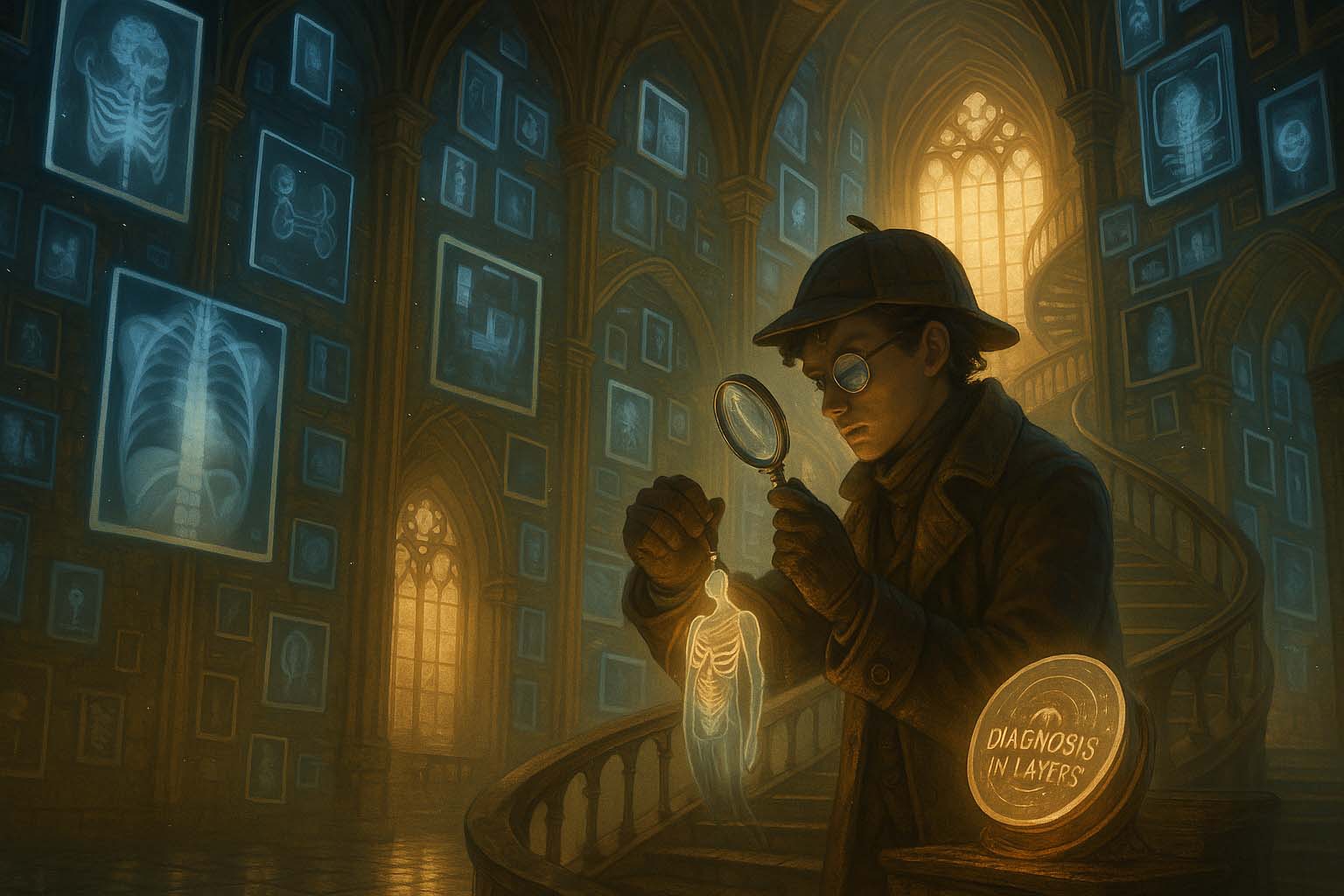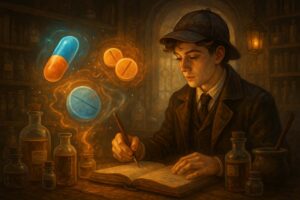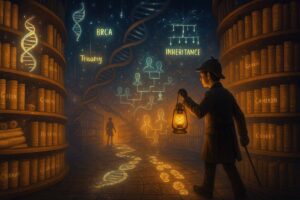
Radiology
- Posted by admin
- Categories Diagnostics & Interventional Medicine
- Date May 24, 2025
- Comments 0 comment
The Shadow Detective’s Domain – Cracking the Cases of Silence, Structure, and the Stories Hidden in Light
1. Introduction: The Scene of the Specialty
Step into the shoes of a Radiology sleuth.
This is the silent centre of modern medicine—the diagnostic engine where images speak louder than symptoms. Radiologists are expert observers, trained to decode the grainy whispers of X-rays, CT scans, MRIs, and ultrasounds. They see what others miss, confirm what others suspect, and often make the first definitive diagnosis. Welcome to a world where a shadow reveals a bleed, a blur maps a tumour, and a single film may change a life.
2. Key Mysteries They Solve (Common Roles & Conditions)
These detectives specialise in solving cases involving:
- Fractures, Pneumonias, and Haemorrhages – urgent reads that guide acute care.
- Cancer Detection and Staging – identifying tumours, nodal spread, and metastases.
- Stroke and Head Injury – rapid brain imaging to drive critical decisions.
- Soft Tissue, Spinal, and Joint Pathology – often invisible without cross-sectional imaging.
Each case requires stillness, focus, and fluency in anatomy—because truth leaves a mark, even in grayscale.
3. Their Trusted Tools & Techniques
Every detective has their kit—and in Radiology, tools may include:
- X-ray and Fluoroscopy – bones, lungs, and contrast studies.
- CT (Computed Tomography) – cross-sectional speed for trauma, bleeds, and complex anatomy.
- MRI (Magnetic Resonance Imaging) – exquisite detail of brain, joints, and soft tissue.
- Ultrasound – real-time, non-invasive investigation of organs, vessels, and foetuses.
- Nuclear Medicine & PET – tracking physiology and metabolism through isotope glow.
This is medicine through images—interpreting light and shadow to reveal the unseen.
4. The Charms of This Field: Why It Captivates the Curious
- Omnipresence: Every specialty relies on radiology—this is the crossroads of all medicine.
- Intellectual Puzzle-Solving: The work is investigative, deductive, and deeply satisfying.
- Technological Frontline: AI, advanced imaging, and precision medicine all begin here.
- Work–Life Balance: Structured workflow and remote reporting offer flexibility without compromising impact.
This is the art of seeing without touching—and guiding without being seen.
5. Challenges: The Toughest Cases They Face
- Diagnostic Uncertainty – Some findings are subtle, ambiguous, or mimicked by artefact.
- Limited Clinical Context – Interpreting images with sparse or unclear information.
- High Volume, High Stakes – Missed findings can have serious consequences.
- Disconnect from Patient Contact – Relational meaning must be found in teamwork and accuracy.
But the experienced radiologist knows: you don’t need to see the patient to see their truth.
6. Famous Cases and Hallmark Clues
- The “Classic Presentation” – CXR showing lobar consolidation: community-acquired pneumonia.
- The “Zebra” – Ring-enhancing lesion in the brain: abscess or glioblastoma?
- The “Aha Moment” – Subtle fat stranding and thickened appendix wall on CT: early appendicitis.
7. Your Training Trail: How to Join the Investigation
To become a Radiology detective:
- Train first in general medicine or surgery, then specialise in diagnostic radiology.
- Develop anatomical precision and a photographic memory.
- Learn to synthesise imaging findings with clinical stories—even when they’re incomplete.
- Embrace pattern recognition, AI integration, and lifelong learning—new modalities emerge constantly.
Whether confirming a suspected tumour or ruling out a bleed in a head injury, your eyes often write the first draft of the medical truth.
8. Final Words: The Signature of the Radiology Detective
Radiology detectives are the eyes of the medical world.
They scan behind the scenes, search beneath the surface, and shed light where uncertainty lingers.
They translate shadows into answers and silence into action.
So if you’re drawn to detail, clarity, and the subtle power of insight—then this is your silent but essential calling.
You may also like

Clinical Pharmacology

Clinical Genetics

